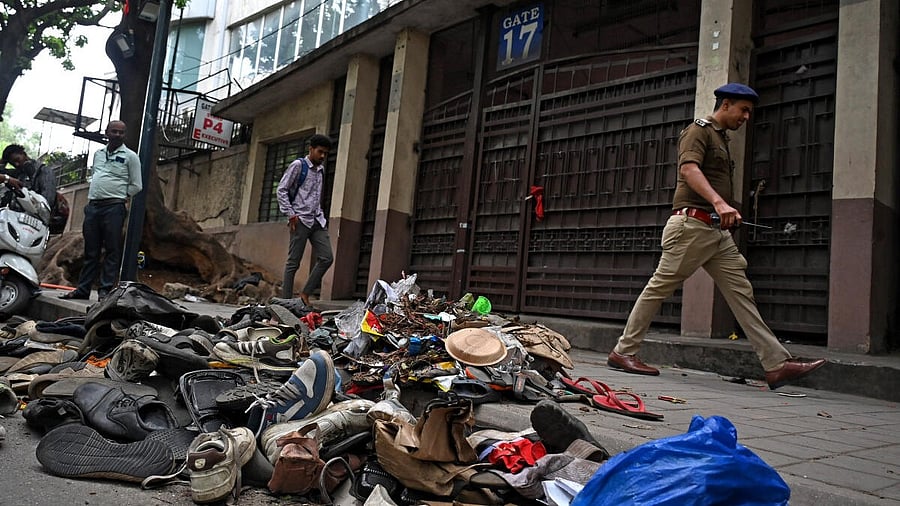
Remains littered the spot on Thursday where 11 people died in a tragic stampede, as thousands of fans had thronged to enter M Chinnaswamy Stadium in Bengaluru to take part in the celebrations of RCB's win in the Indian Premier League.
Credit: DH Photo/Pushkar V
M Shashidhar Reddy
The tragic stampede during the celebrations for the Royal Challengers Bangalore (RCB) after their return to Bengaluru with the IPL 2025 cup is a heart-wrenching incident that few could have foreseen. However, the failure of local authorities to adopt an anticipatory crowd management strategy marks a serious lapse. Both proactive and reactive crowd control measures were conspicuously absent.
Initially, it was believed that the police had opposed holding the event and that no official approval had been granted. Despite this, Chief Minister Siddaramaiah posted on his X handle at 1:40 pm on Wednesday that the government would felicitate the IPL champions at Vidhana Soudha at 4 pm — a decision that appeared to override police concerns. The following day, the High Court of Karnataka took suo motu cognisance of the tragedy, a welcome development. Subsequently, a one-man judicial commission headed by former Karnataka High Court Judge Michael D’Cunha was constituted. The state government also placed under suspension all police officials responsible for the stadium’s jurisdiction, including the city police commissioner, pending the inquiry. However, this move may be viewed as a diversionary tactic, deflecting focus from the government’s decision to proceed despite warnings. Judicial scrutiny will hopefully bring greater clarity and accountability.
Systemic gaps
Gaps in disaster management are evident across the country, and Karnataka is no exception. Disaster response continues to be primarily reactive—rescue and relief— rather than encompassing prevention, preparedness, and mitigation before a disaster and rehabilitation and reconstruction afterwards.
The Disaster Management Act, 2005, established the National Disaster Management Authority (NDMA), chaired by the prime minister, with a full-time vice chairman and members, and provided for State Disaster Management Authorities (SDMAs), headed by state chief ministers, with their composition determined as deemed necessary.
In Karnataka, as in most states, the revenue minister serves as vice chairman of the SDMA, with ministers as members. These ministers, with their legislative responsibilities and high public expectations, often cannot devote sufficient attention to disaster preparedness. When a disaster strikes, the political and administrative machinery focuses on immediate rescue and relief, followed — though not always promptly— by rehabilitation and reconstruction. Pre-disaster planning across all hazards remains neglected. This is a serious drawback that must be addressed.
The chief minister should consider appointing a full-time vice chairman of the SDMA, with cabinet rank, supported by experts as members and a dedicated secretariat.
Since its inception, the NDMA has released guidelines for managing various disasters with input from leading experts in scientific and academic institutions, as well as officials from central and state governments. Although these guidelines have been made available to all states, they have been largely underutilised, including in Karnataka. Additionally, there are guidelines on the incident response system that outline the roles and responsibilities of disaster management agencies.
Concerned at the recurring stampedes at places of mass gathering, including religious places, and typically ad-hoc responses to those, NDMA formulated National Guidelines on Managing Crowds at Events and Venues of Mass Gathering in 2014 to enable an integrated and structured approach to crowd management at such places. It was expected that it would help organisers of events, administrators and other stakeholders to effectively deal with them.
While time constraints may have played a role in this particular stampede, the systemic inadequacies are evident. It is hoped that this tragic incident will serve as a wake-up call for Karnataka to totally revamp its disaster management strategies and ensure that these and all other guidelines seamlessly cascade with disaster management plans prepared at various levels in the state administrative hierarchy.
While disasters are inherently tragic, resulting in loss of life and property damage, they also provide valuable lessons. They help us understand vulnerabilities, identify weaknesses, and act as catalysts for conducting drills that enhance preparedness. Furthermore, they highlight the need to integrate disaster risk reduction into development plans. In light of the Bengaluru tragedy and recent stampedes at the Kumbh Mela in UP, Delhi Railway Station and Goa, NDMA must immediately step in to review and update existing guidelines and revise the plans and standard operating procedures (SOPs) based on them to create a roadmap for the nation to ensure that such incidents are avoided in future.
(The writer is a former vice chairman of the NDMA)
Disclaimer: The views expressed above are the author's own. They do not necessarily reflect the views of DH.